1970s Fashion – The decade of ready to wear
The 1970s and 1970s fashion have been labelled “The Decade That Taste Forgot”. Granted, this was in the 1980s, when the exuberant proliferation of styles and embracing of the home-made and the alternative of 1970s fashion seemed like an embarrassment to the more streamlined and colour matched fashions that followed.
1970s fashion – an exuberant choice of styles
Contemporary commentators complained that 1970s styles had no direction and they were too proliferate. French couture no longer handed down diktats of what we should be wearing and, in fact, started to imitate street style.
And street style was great, it was inventive, it was comfortable, it was practical for women, it was glamorous, it was home-made, it was whatever you wanted it to be, not what society, a few French couturiers, or a fashion magazine said it should be.
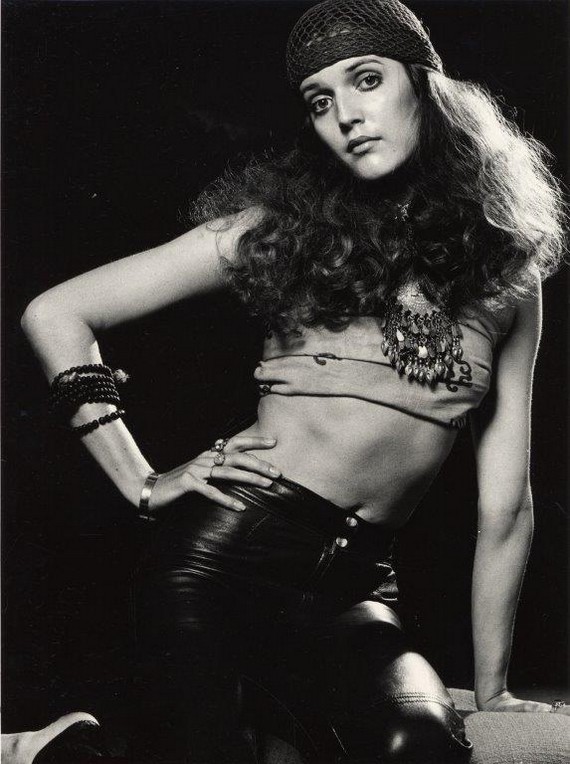
Judith Baragwanath photographed by Max Thomson in the Hill Thomas Jensen Studio, Auckland, NZ, in the early 1970s
Eclectic 1970s fashion
This mean that glittery disco queens with outrageous makeup and massive hair stood alongside working women in tailored suits with minimal makeup, gender neutral clothing truly broke ground with women wearing trousers and jeans as a mainstream fashion, there were hippies, there were retro and ethnic styles, there were romantic and peasant styles and finally punk came snarling along and spat at the lot of it.
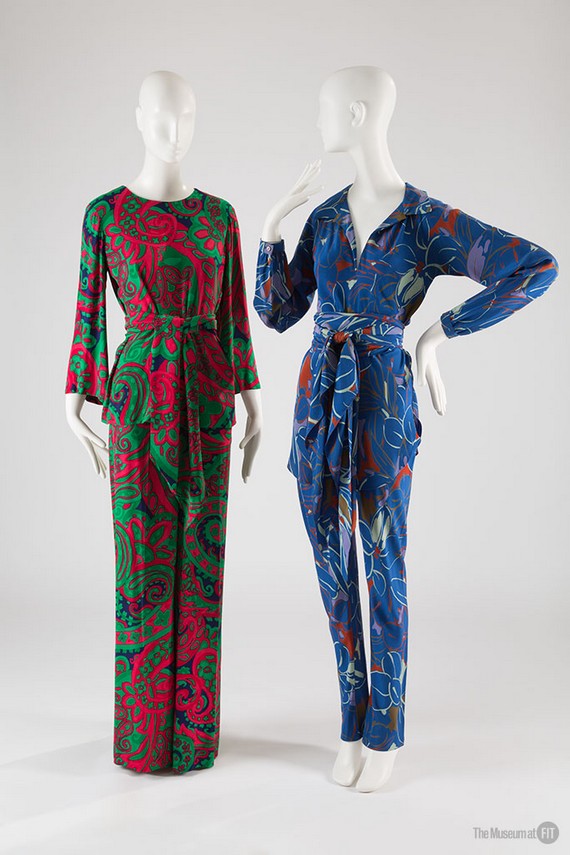
YSL Saint Laurent (Left) Rive Gauche, 1970 + Halston (Right pajama, 1976 sets.
Couture of the 1970s
It’s hard to imagine the monopoly that Paris had on fashion styles in the Western world before the 1950s. High fashion came only from France, and if you could not buy from a couturier then you copied the style and colour, with magazines and fashion plates to guide society as to what one should be wearing where and when.
Etiquette
There was a rigid etiquette on what time of day and for what event as well as what season and of course year a style of dress should be worn. But after the Second World War, when Paris and its couture salons had been cut off from most of the rest of the world, its position slipped, and during the 1950s and 1960s Parisian couturiers became less and less important.
Fashion these days was less about the older women who patronized the Parisian salons and more about younger people who now had disposable incomes and a hunger for new clothing styles.
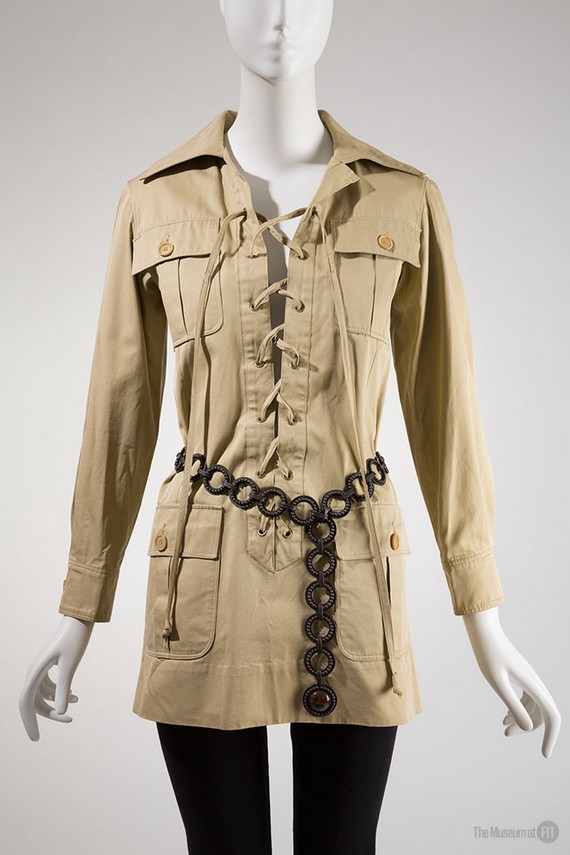
1970s Saint Laurent Rive Gauche Safari jacket
The media and diffusion lines in 1970s fashion
By the 1970s, the media was sounding couture’s death knell. In 1972 the Evening Standard announced that they would not be “spending any more time reporting the funeral obsequies of a moribund institution.”
But some designers realised there was a new way to keep the world’s attention. They produced diffusion lines, the more affordable (yet still ridiculously expensive) ready to wear collections that we know as “Designer Labels” today. Yves Saint Laurent was on the forefront of this, with his Pret-a Porter YSL Gauche label.
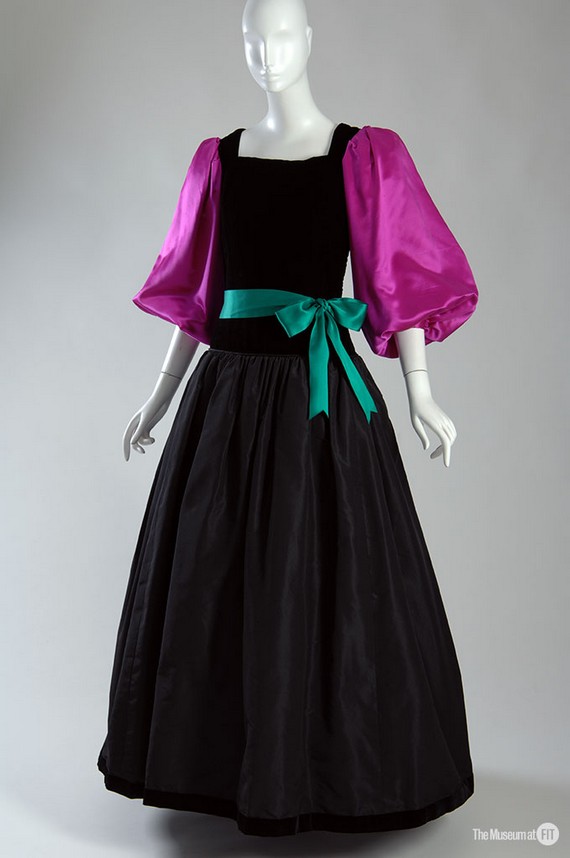
Black, fuchsia and teal satin, velvet, and taffeta Yves Saint Laurent evening dress, 1976
Yves Saint Laurent
Yves Saint Laurent was also one of the first couturiers to borrow directly from street style 1970s fashion trends , making his own upmarket version of hippy crafts with his luxurious silk patchwork dress, and co-opting the “peasant” and “ethnic” style in his own way: adding fur that was not second-hand as was more common than, and gleaming new velvets in gorgeous colours.
He also originated a nostalgic trend for the 1940s with his own version of their boxy fur jackets, turbans and wedge heels, which soon developed into one of 1970s fashion ‘s most known footwear trends, the platform sole.
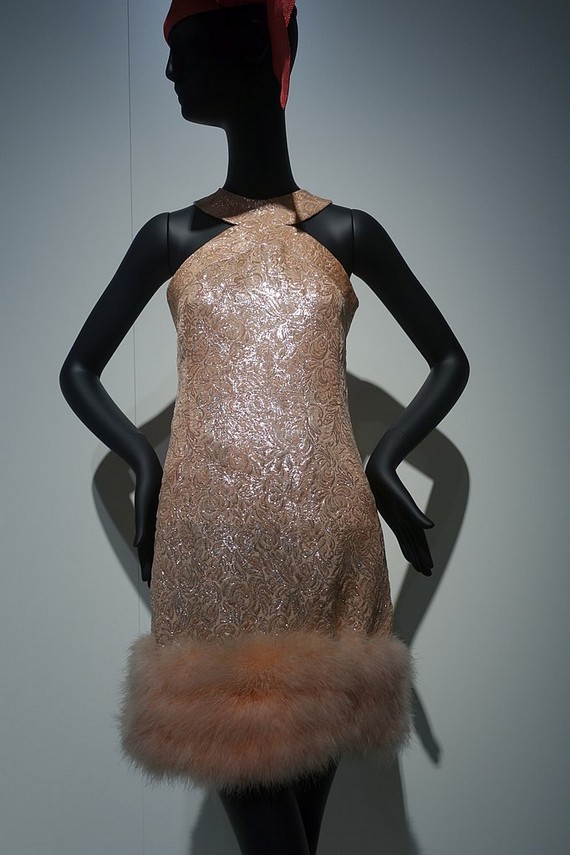
Pierre Cardin 1970s metallic cocktail dress with ostrich feathered trim
Pierre Cardin
Other designers had licensing deals too, like Pierre Cardin. He was Saint Laurent’s major rival, and in the 1970s he, along with several other designers, turned to soft and drapey knit fabrics to produce innovative, fluid dresses and clingy tops.
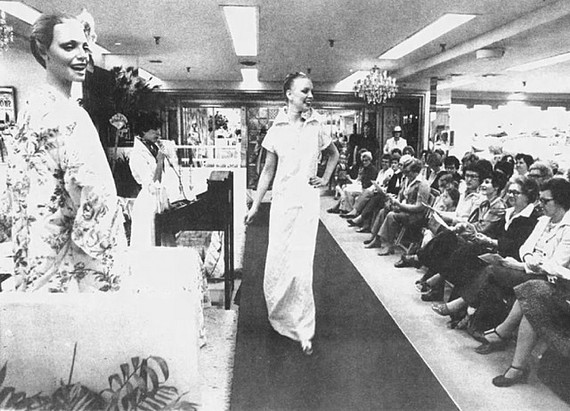
A model walks down the runway at a fashion show in 1971 at In-store Fashion Show at Hess Brothers Department Store in Allentown, PA
70s skirt lengths in 1970s fashion
The universal skirt length of the 1960s had been the mini, and in 1970s fashion this dropped to the maxi, which was ankle length. Whilst it went down well in Britain, American women found it frumpy and so the Midi was trialled, an unflattering calf length style which was neither here nor there, as its name suggests.
Some designers tried to soften the effect of maxi skirts a different way, by placing thigh high slits in them; Cardin produced a dress with a fringe ending in discs as his solution.
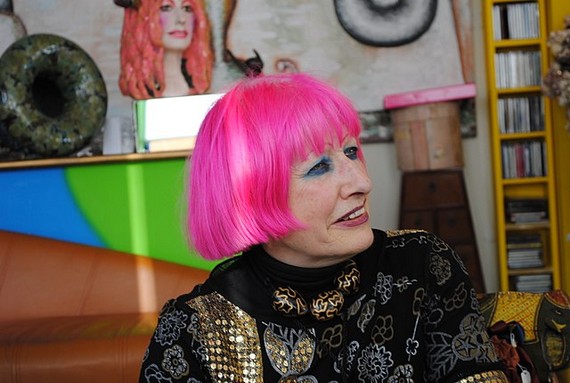
Dame Zandra Rhodes, 2012
Zandra Rhodes
The British designer Zandra Rhodes’ answer was the handkerchief hem, which has triangular points like a handkerchief held diagonally, so producing a simultaneously long and short skirt. Her collections were inspired by the textile traditions of many different cultures, including historical British knitting and embroidery stitches.
They were named things like “The Ukraine and Chevron Shawl”, “New York and Indian Feathers”, and “Paris, Frills and Button Flowers”. Her maximal designs were in demand for special occasions, and Princess Anne commissioned her to make the dress for her engagement photos in 1973.
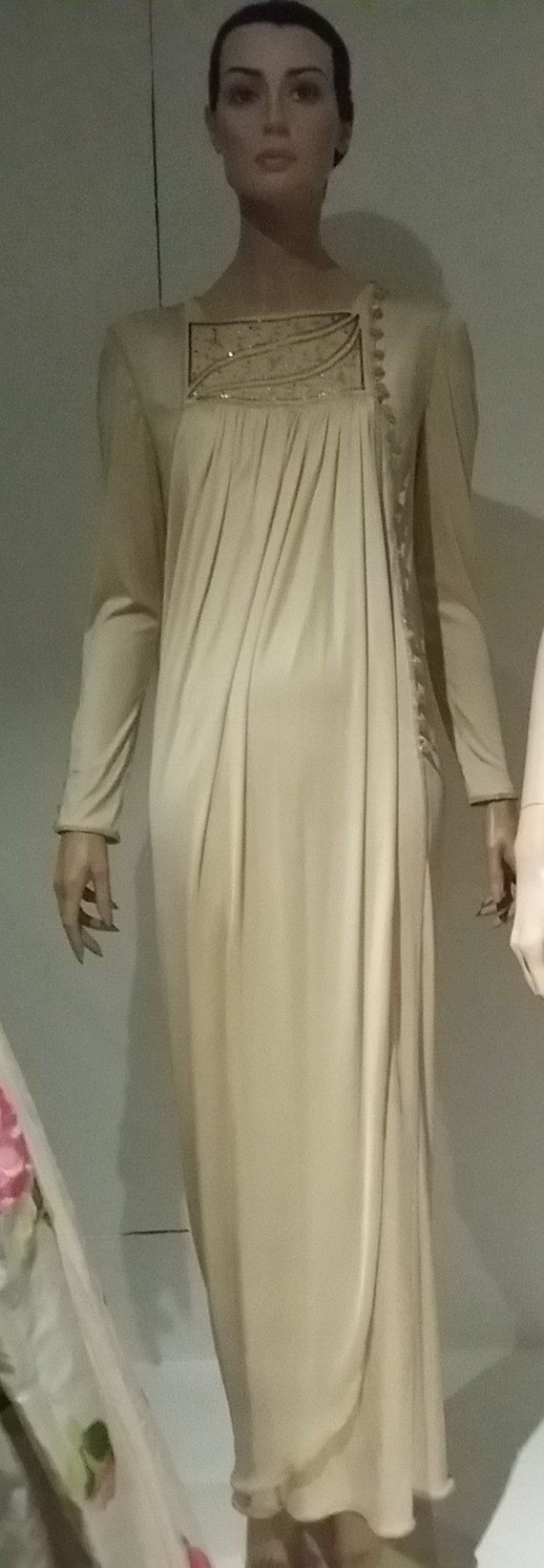
Bill Gibb evening gown, late 1970s
Bill Gibb
The Scottish born designer Bill Gibb is often linked with Zandra Rhodes. They had a similar design aesthetic, with Gibbs being influenced inspired by folk, medieval and Renaissance clothing as well as by Highland dress.
His pattern on pattern garments were further decorated with ornate trimming. The full-skirted dresses he made were romantic and fantastical.
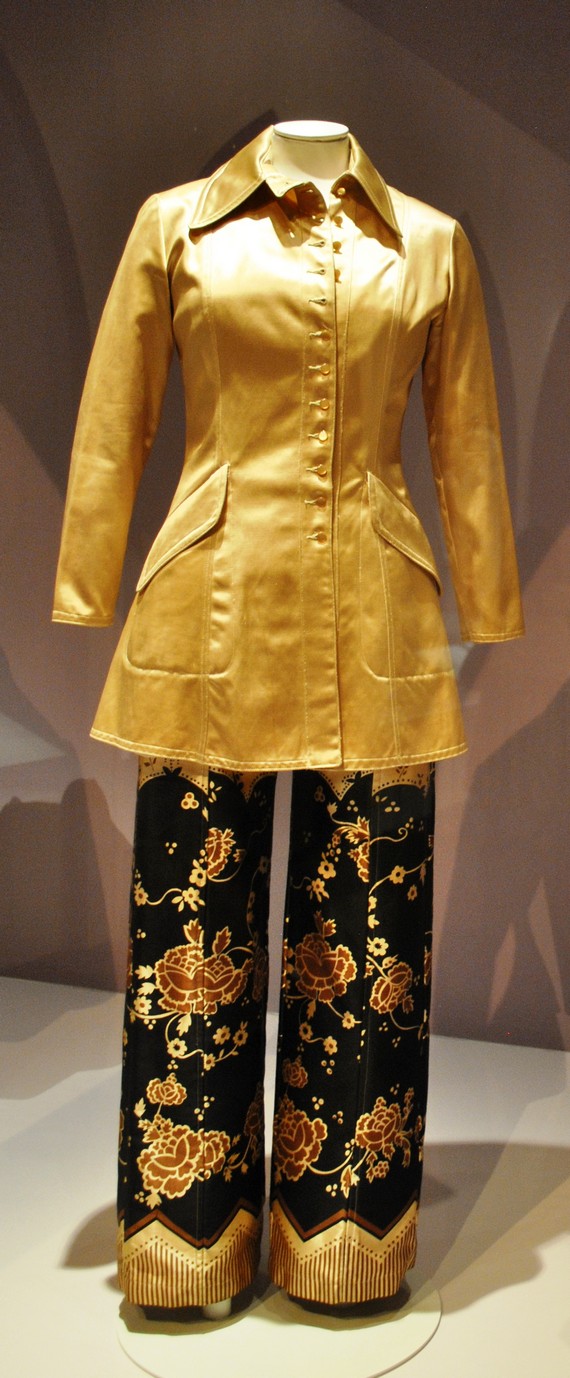
Lamborghini trouser suit by Ossie Clark and Celia Birtwell
Ossie Clark and Celia Birtwell
Ossie Clark was also a British designer who worked with his wife, Celia Birtwell. She was a print designer who created the colourful patterns that complimented Clark’s cleverly cut, romantic yet sexy dresses in heavy moss crepe.
Jean Muir
The British designer Jean Muir worked in a completely different idiom. She produced minimal understated designs for serious women in plain matt jersey. Her colour palette was restrained and neutral and always included sensible navy blue and black.
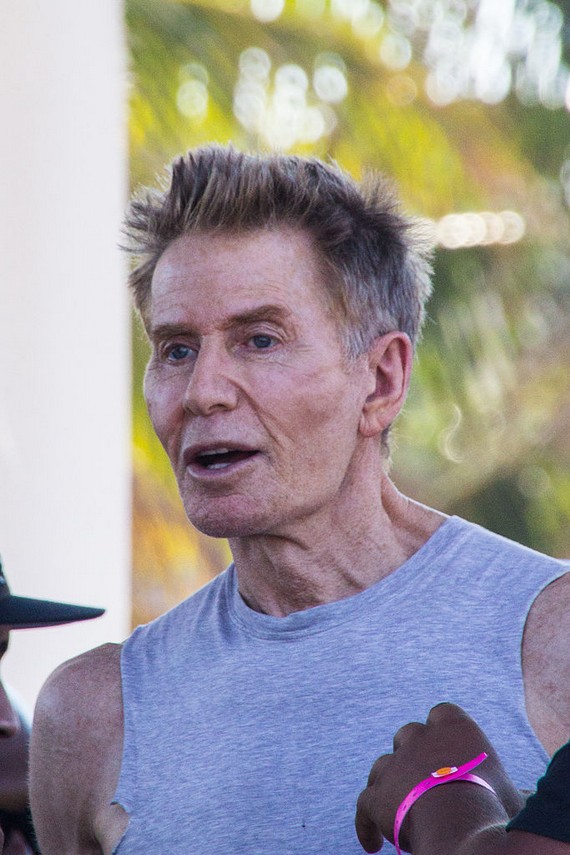
Calvin Klein in 2014
Calvin Klein
Calvin Klein was another designer who also had his start in 1970s fashion . Klein is an American designer whose understated style is still going strong today.
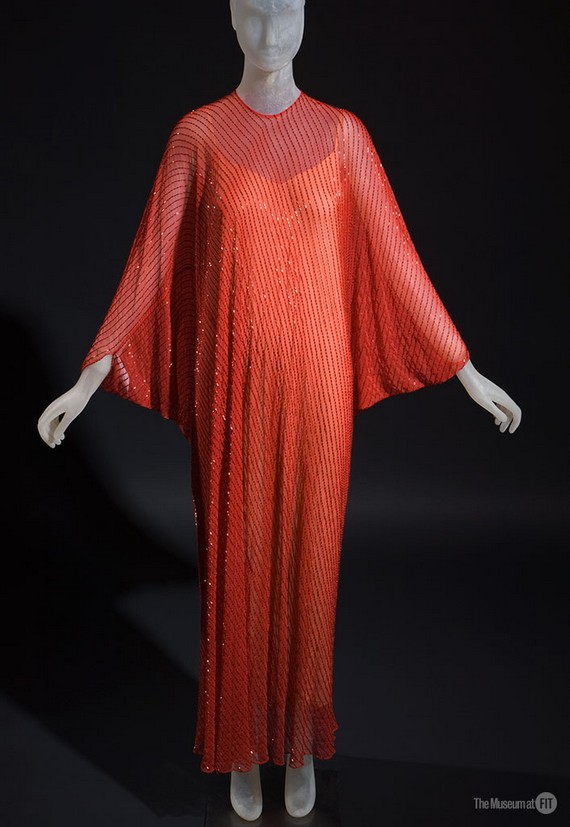
Halston orange evening caftan, 1977
Roy Halston
Roy Halston, another American designer, also created minimal designs in draped jersey, but in contrast to the sensible work of Jean Muir his designs were as sexy as could be, and his most famous designs were an update of Grecian goddess gowns in slinky silk which transformed a woman into the most glamorous creature in the room.
Mary McFadden
Mary McFadden was another American designer who took inspiration from the “simple” clothing of ancient Greece – she invented a permanently pleated satin to make her column gowns from.
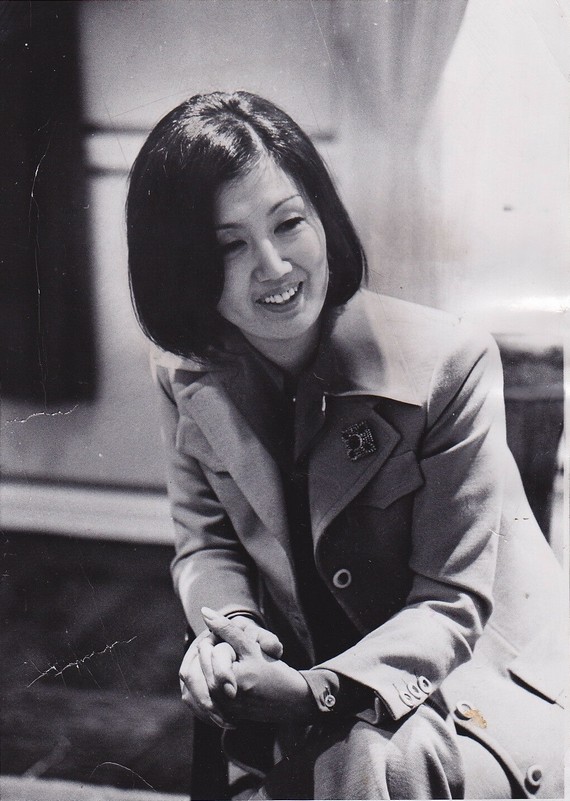
Japanese fashion designer Hanae Mori in 1974
Japanese designers
Several Japanese designers came to international attention during 1970s fashion . Yuki (Gunyuki Torimaru) chose a Western aesthetic of body consciousness working like several others in draped jersey.
By contrast Kansai Yamamoto, Issey Miyake and Kenzo Takada created a modern east/west look by using traditional Japanese loose and layered designs and ideas of space in relation to the body with their own tweaks to create something that had never been seen before.
Hanae Mori, another Japanese designer was inspired by Japanese design motifs and textiles but with a more western shape.
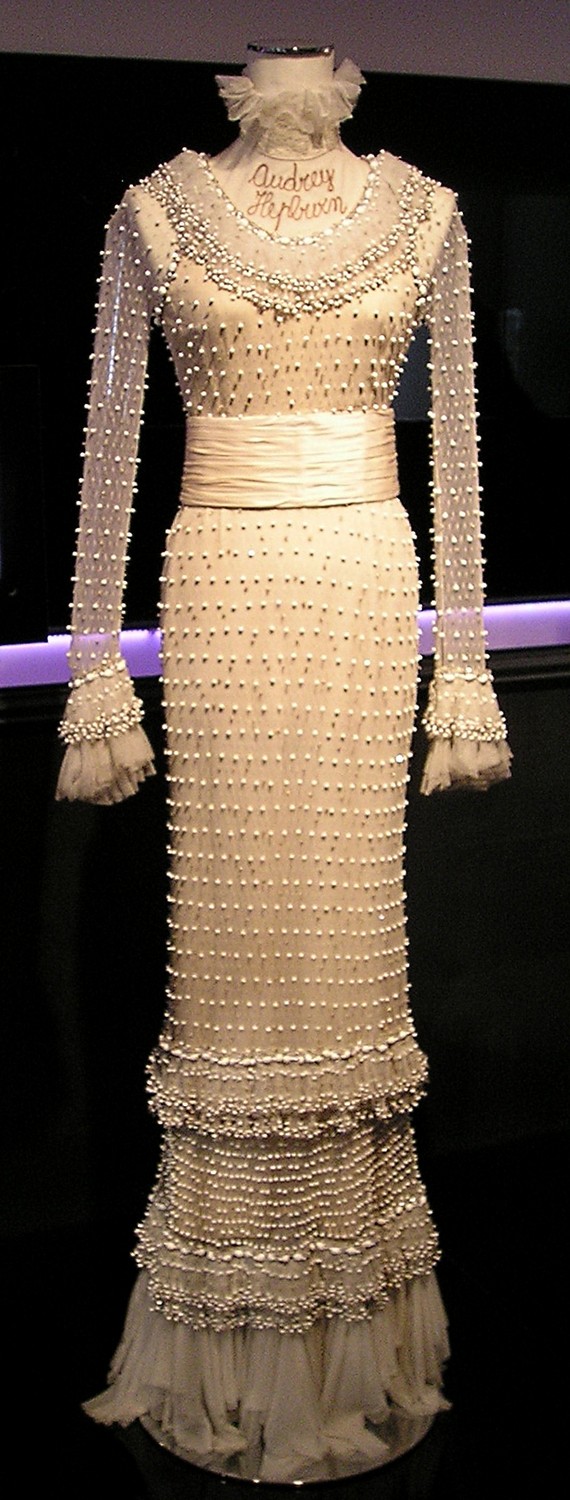
Valentino evening_gown worn by Audrey Hepburn
Italian fashion industry
The Italian fashion industry was flourishing by the mid 70s. The country had always had a reputation for quality in manufacturing, particularly silks, wools, linens and leather.
Italian designers Valentino and Mila Schon who had been established for quite some time were joined by newcomers Giorgio Armani and Gianni Versace. The Missoni brand developed their knitwear and worked in a highly coloured pattern on pattern layered aesthetic.
The first Milan fashion week was inaugurated in 1975 and immediately became a fixture for the international fashion buyers and press.
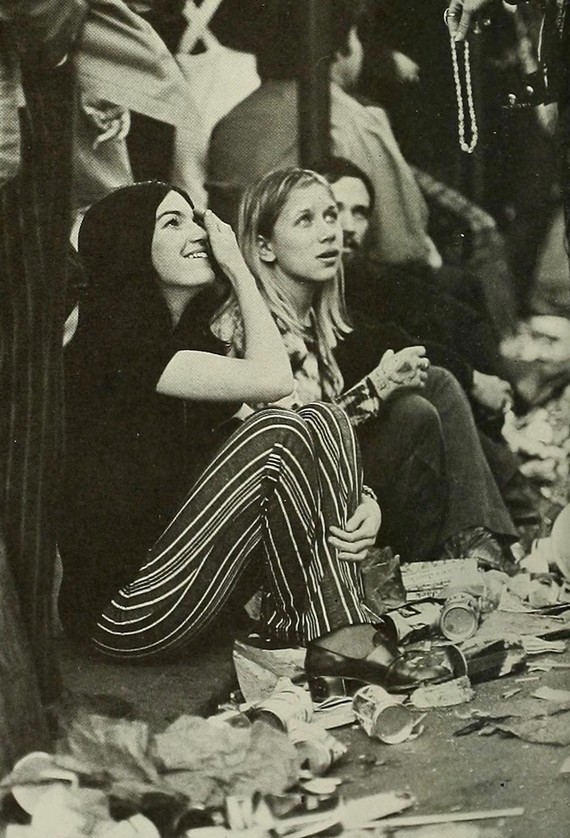
New Orleans Mardi Gras 1970
The Hippies and the economy
The 1970s saw an economic depression in the UK. Striking miners meant that electricity was drastically reduced, leading to the “Three day week” where electricity was only supplied to businesses on those days. This affected income.
It was also an era when people were constantly worried about the nuclear threat, and felt helpless that at any moment “the button” might be pressed, obliterating the entire world.
This coincided with a rising Eco-conciousness, and in an effort to save money and the world people looked for second-hand clothing and turned it into a fashion statement. They also made their own, and the 1970s fashion for crochet and patchwork look took off.
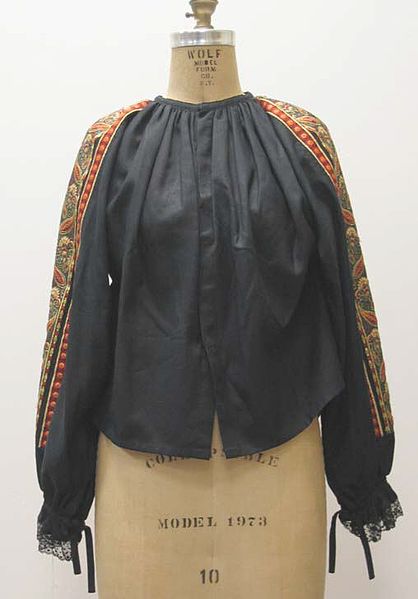
Embroidered peasant blouse
Influences from afar in 1970s fashion
At the same time, people had more ability to travel and take foreign holidays as this became cheaper and more accessible. They brought back souvenirs and clothing from their travels, and these cheap clothes from other countries, particularly India began to be imported in large numbers.
“Peasant” style embroidery was also introduced as design details for those who didn’t want to go for a head to toe look.
This wasn’t just a case of bringing back personal mementos, but of regarding these other cultures as somehow both more innocent and more wise that Western ones.
Historical, particularly American prairie or British Edwardian style dress looked to similar ideas of an imagined era of innocence in the troubling atmosphere of the 1970s. Laura Ashley’s milkmaid styles and Ralph Lauren’s Prairie dresses were seized upon 1970s fashion .
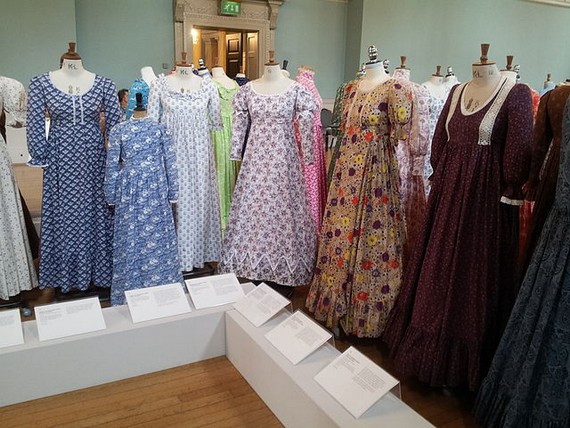
1970s Laura Ashley dresses
Punk in late 1970s fashion
Punk in the 70s was a really localised affair for several years as Vivienne Westwood and Malcolm McLaren, who owned a retro clothes shop in London’s King’s Road, went to New York one summer and were bowled over by the music groups the New York Dolls and the Ramones.
McLaren in particular was keen to manage and style them, but they already had a style all of their own. In addition, the somewhat sheltered Westwood met poets and heroin addicts who managed to carry off their ripped and ragged, safety pinned back together clothes with aplomb.
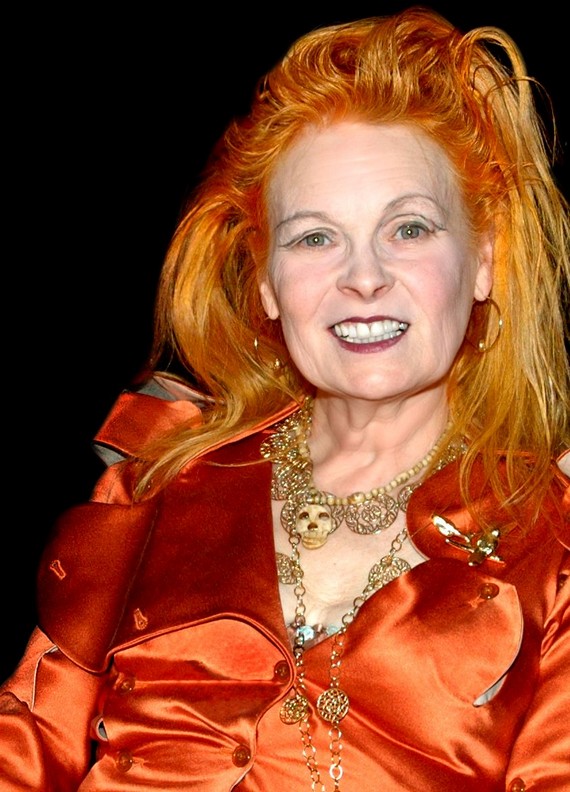
Vivienne Westwood
Vivienne Westwood
Westwood, an inventive clothes designer and creator who up until now had been customizing t-shirts for her shop was highly inspired. She began to make what would become punk t-shirts, with zips which would open over a nipple, and chicken bones painstakingly attached to spell out words.
In addition there was a bondage element to Westwood and McLaren’s new look, featuring straps and rubber, with Westwood making some garments and some coming from fetish companies. The other thing that Vivienne added to the mix was tartan, whose colourful checks clash nicely with the predominant black colour scheme.
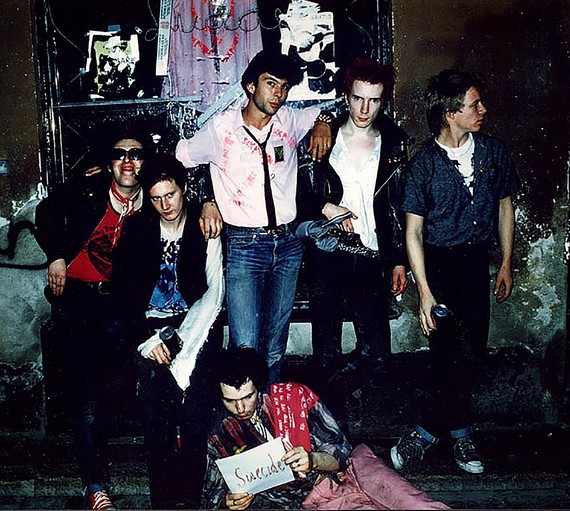
Original London Punk Rockers Tommy Dollar and the Sex Pistols, 1979
The shop and The Sex Pistols
Malcolm McLaren applied these clothes (there’s no other way to describe it) to the spotty teenagers who hung around the shop, and in 1977 formed a pop group, The Sex Pistols. They were chosen not for their singing or musical ability (they had none), nor for any good looks (this too is debatable) but for their skinny bodies and raw attitude.
They went on to cause just the right shock waves, appearing on live TV in their strange and outrageous outfits and shocking the nation by swearing on air.
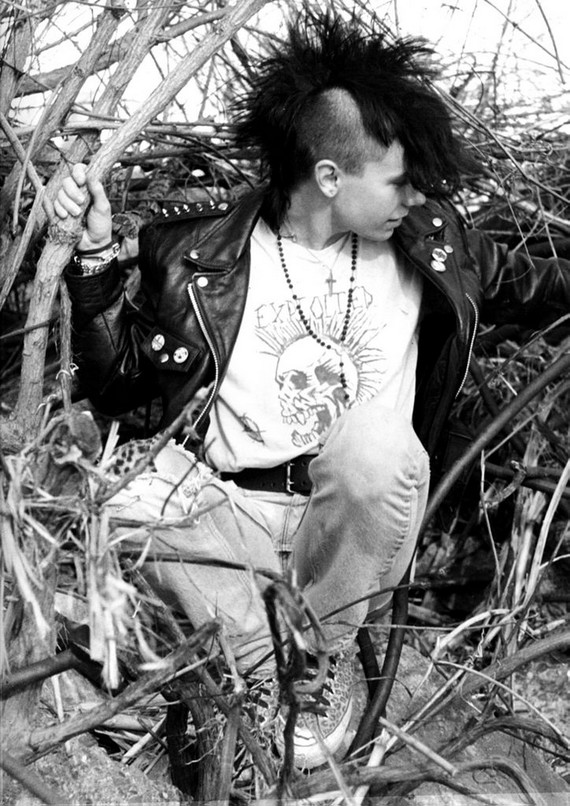
Mohawk punk
The clothes
Westwood and McLaren’s clothes, although sought after, were actually very expensive for the average person, and naturally copies sprang up and people started to produce their own as the style influenced 1970s fashion as a whole. (The Sex Pistols trashed the outfits they were given, not realising they weren’t free – the damage came out of their wages to their dismay).
The basis of the street version was a decorated black leather biker jacket, with studs, chains, and painting added, and ripped and safety pinned clothes.
Hair
Hair was spiked, shaved, left long in unexpected patches or grown into a towering Mohican. It was also dyed black, bleached blond or tinted in bright colours. Makeup, for both men and women, was inventive. It featured pale faces and angular, exaggerated eye make up, sometimes with triangles of obvious, equally angular blusher on the cheekbones.
The Working Woman
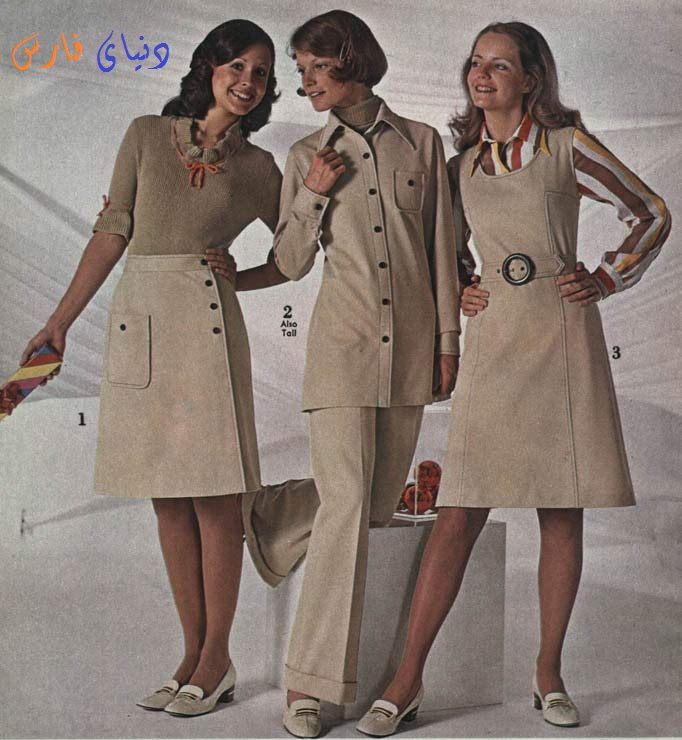
Suitable office wear in the 1970s, 1972_womens beige outfits
More women than ever before were taking on traditionally male roles in the workplace, although conditions were far from equal. Sartorially, women tried to indicate that they were the same as men by dressing similarly, with a minimum of feminine touches. Makeup was de riguer but neutral, and hairstyles were neat.
The preferred look for a woman working in an office was tailored and relatively masculine, with tailored skirt or trouser suits with small shoulder pads, worn with neat blouses and sometimes silk scarves around the neck to minimize skin from showing. The suits were often made from an easy to wash and dry, heavy stretch or knitted man-made material as well as the more traditional woven fabric, as women looked for more comfortable clothes that made their lives easier too.
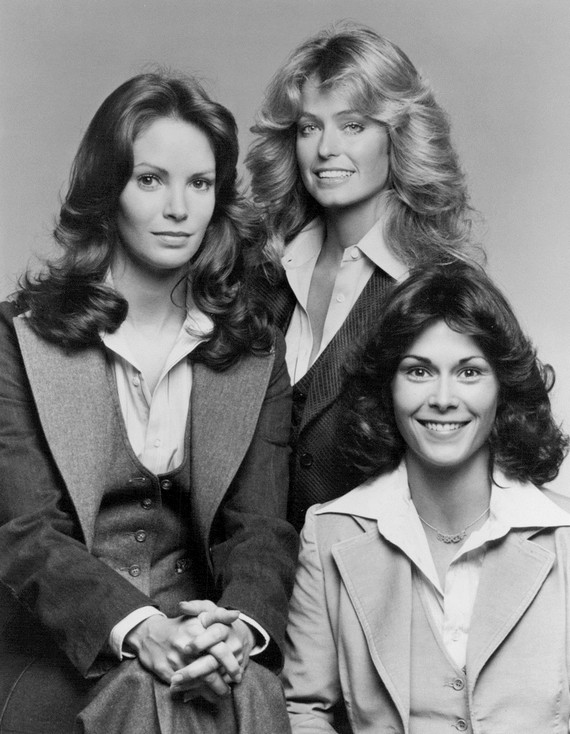
Charlies Angels cast, 1976

A more funky work wear look
1970s Disco Fashion
Disco outfits were all about dressing up and looking as glamorous as possible, with body conscious styles for both men and women.
There was lots of makeup for the women, and vast attention to grooming for the men. Glitter, metallic lame and sequins were all popular for their ability to catch the light and look dramatic in a dark club – white was worn for the same reason.
John Travolta’s white suit in Saturday Night Fever (1977) and Bianca Jagger’s white Halston dress, worn to Studio 54 which was the ultimate New York disco destination, became iconic examples of 1970s fashion .
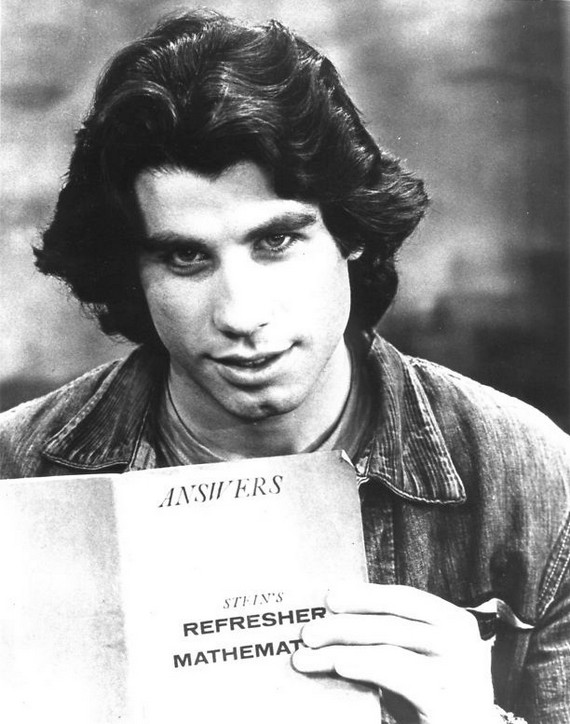
John Travolta, 1976
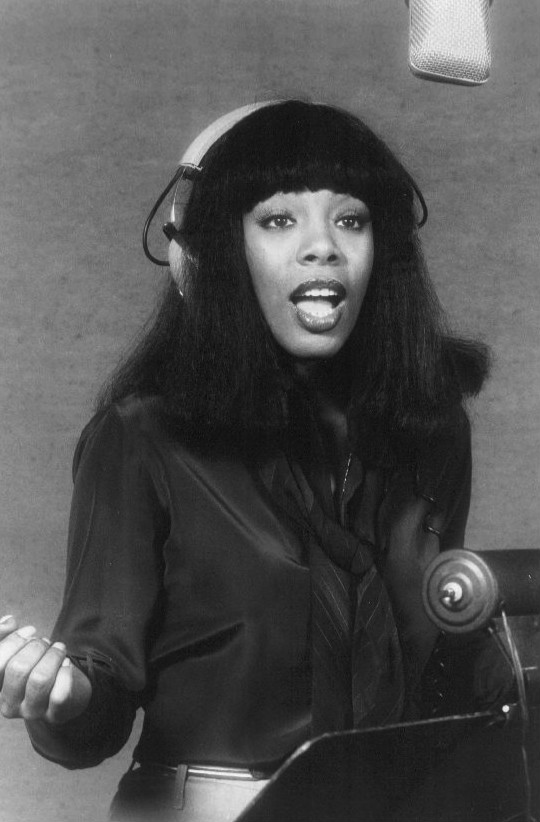
Donna Summer, 1977
Glam Rock and 1970s fashion
Glam Rock was an even more outrageous extension of the disco look for music performers in 1970s fashion. It involved mainly men, wearing outrageously high platform boots, tight clothes and glitter makeup. David Bowie, Roxy Music, Sweet, Slade, Mott the Hoople, Mud and Alvin Stardust all exemplified different variations of the Glam Rock look.
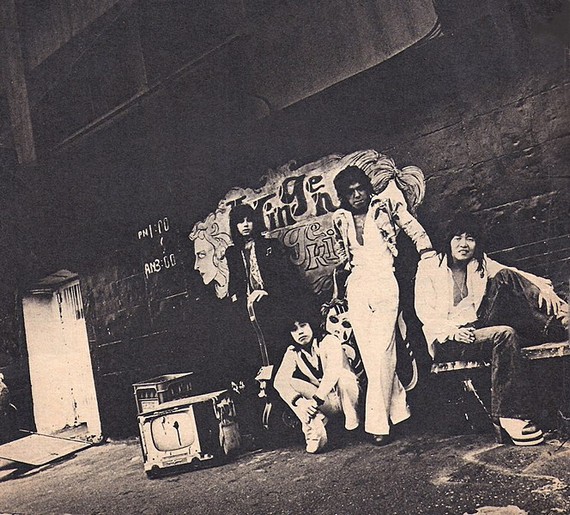
Glam rock band – Vodka, 1972
Northern Soul
Northern Soul was a fashion and music movement from the North of England during the late 1960s and early 1970s. The music Northern Soul fans loved was rare American soul tracks, and they developed their own dance moves to it. The movement was also associated with drugs, particularly speed, that the dancers relied upon to keep their energy up all night.
Italian fashion and sharp tailoring
The initial look was very similar to the Mods, with aficionados worshiping Italian fashion and its sharp tailoring, adding to the Italian blazers with shrink to fit Levi jeans, Trickers and brogue shoes and bowling or baseball shirts, and pork-pie hats.
However, Northern Soul soon developed its own look too, more conducive to dancing with high-waisted, wide trousers and tank tops covered with sewn on badges showing their membership to soul clubs. Black racing gloves showed their sympathy with the American Black Power movement.
“If the first line of northern soul’s credo was “we love the music of black America”, the second was “we love the fashions of Milan”. Regretfully, the third was “we love the products of the pharmaceutical industry”. -Paul Mason, a Northern Soul fan.
1970s fashion Casual Wear
The most noticeable thing about casual wear in 1970s fashion was that the gender lines were incredibly blurred – not only did trousers and jeans finally become so normal for women that nobody looked twice when they wore them, but men’s clothes became much tighter, more colourful and “feminine”.
In fact, men’s and women’s wear had come so close that unisex outfits were often seen, with the same clothing design available for both men and women.
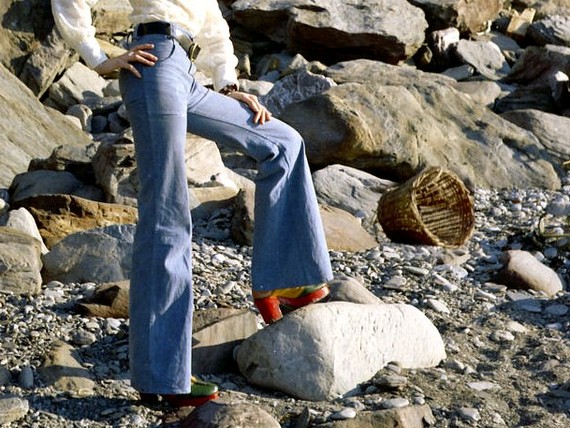
1970s blue denim Bell bottoms
Trousers in 1970s fashion
The favourite trouser shape for both genders was the bell bottom, or flares – tight on the bum and upper legs, flaring from the knee to the ground. They could be worn as jeans, trousers or bibbed dungarees. A tight, sometimes cropped, t-shirt was worn with them.
For women, although the maxi skirt was in fashion and the mini skirt had gone out, an even tinier option for the lower half existed – hot pants. These shorts were almost as small as knickers, and worn to best effect with heavy denier coloured tights beneath.
Jeans in 1970s fashion
Jeans in 1970s fashion came in a real plethora of finishes and shapes, from tight and stonewashed to dark denim flares, to pure white. They could be worn sharply creased down the middle with a blazer for a smart style. Jeans brands were carefully chosen – Gloria Vanderbilt jeans were very desirable, whilst Mods and Northern Soul boys had to have Levi’s.
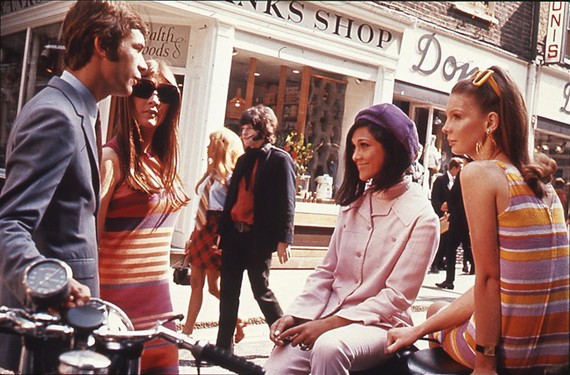
Carnaby Street, London
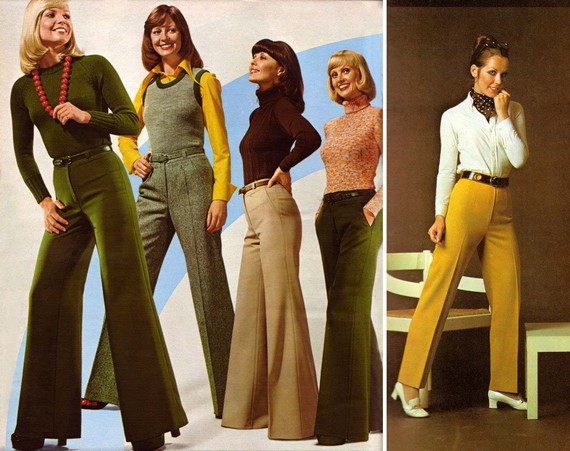
Flares and tank tops in 1974
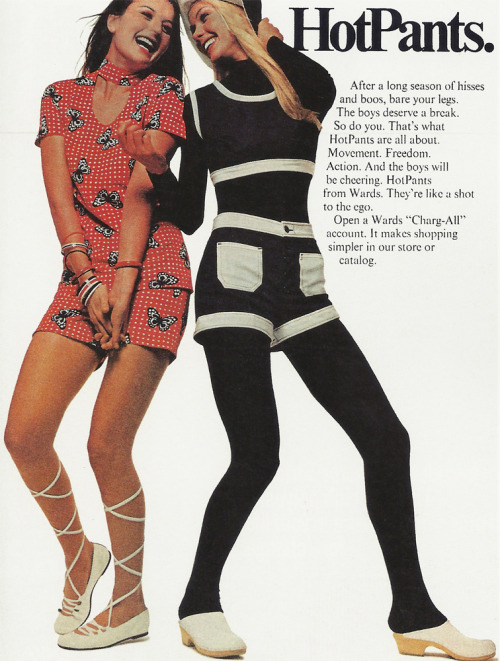
Hot-pants advert, 1974
1970s Wedding Dresses
The fashion in wedding dresses was in line with both 1970s evening wear and day wear looks, with some very body conscious Halston-esque jersey numbers, but on the whole the innocent, ruffled prairie dress and peasant styles were the most popular, often with lots of lace and high necks, invariably in white.
In fact, this romantic style persisted well into the early 1980s, although it had long dropped out of fashion for every day wear by then.
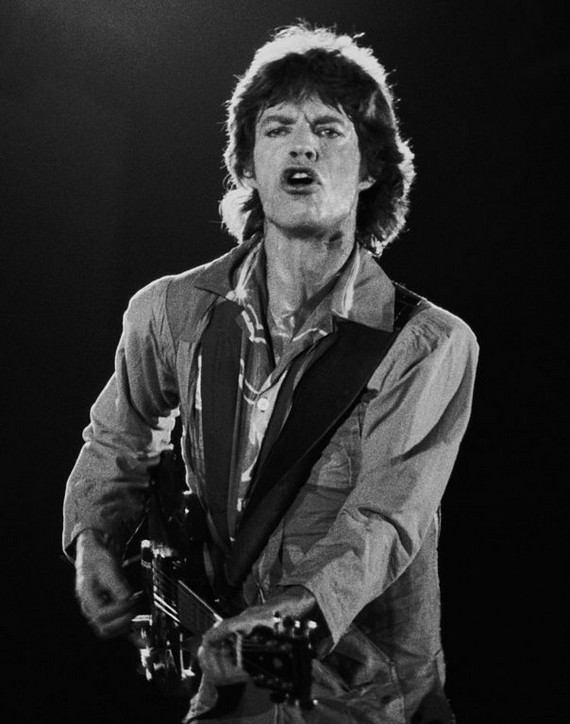
Mick Jagger, 1982
Bianca and Mick Jagger
Bianca Jagger went entirely the opposite way in her 1971 wedding to Mick Jagger. Her outfit was white, but extremely sophisticated, consisting of a long-line fitted jacket by Yves Saint Laurent worn with nothing beneath so that side boob was visible, and an ankle length skirt topped with a huge veiled picture hat.
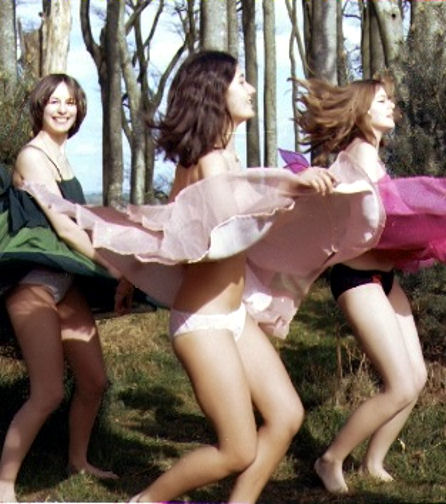
Twirling Dancers with Skirts, Caroline Design Disco operated mid to late 1970s and incorporated its own team of dancers. L to R: Doreen, Jan, Alison.
1970s Underwear
The really nice thing about underwear shoots for the 1970s is the amount of re-touching that wasn’t going on. Sure, women were slender with long legs, but they weren’t impossibly tall and thin, i.e. photo-shopped that way, and their skin looks good but not flawless. Airbrushing and photo retouching did exist (retouching has been around as long as photography has) but it wasn’t used as extensively or as automatically as today.
Nylon in 1970s fashion
Nylon was very popular for underwear in 1970s fashion , and its sheer qualities were appreciated. The romantic trend continued beneath clothes with ruffled baby dolls, nightdresses and negligees in pastels, mint greens, and baby blues, but nude bras which didn’t show under clothing also gained hold for business women.
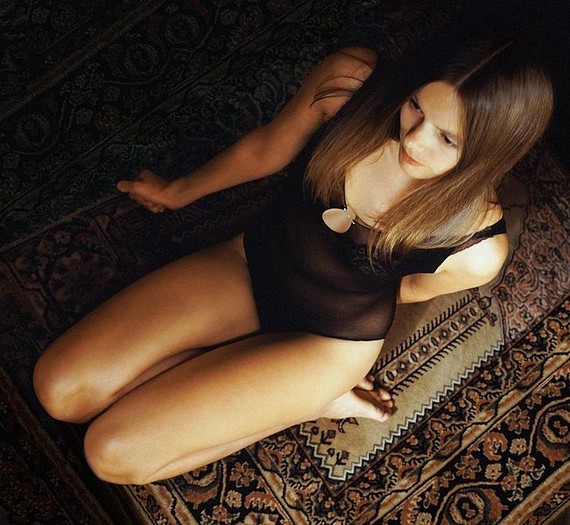
Girl in body stocking. 1970
Stockings
Stockings were still worn, but tights were much more widespread for their practicality. All in one body stockings, incorporating a bra and tummy flatting panels were also adopted, particularly for the “Dress For Success” women wanting a sleek look.
Beachwear in the 1970s
The briefest of triangle bikinis were in vogue for 1970s fashion , made of shiny nylon or crocheted, as were swimsuits with cut outs. Halter necks or strapless swimsuits ensured minimal tan lines. A very dark tan was desirable and that’s one of the reasons the bikinis were little, with sun worshippers basking for hours unaware of the dangers.
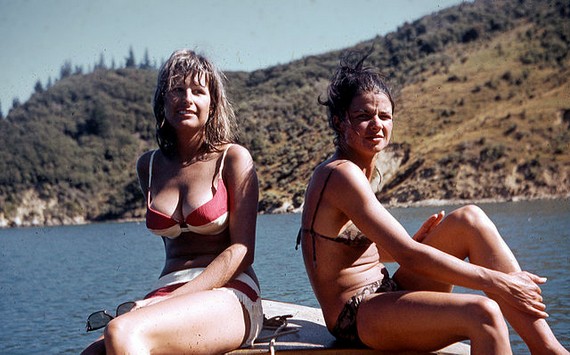
Two Women in bikinis, New Zealand, 1970
Sportswear in 1970s fashion
Fabric technology was continually moving on and lightweight, waterproof fabrics were useful for ski wear, and nylon and lycra mix was very useful for skin-tight leotards worn over leggings for exercise (although the major aerobics craze was a few years in the future).
Both genders competing in the 1972 Olympic ski team wore skin-tight maroon nylon unitards with a white trim and white polo necks underneath.
Knitted nylon tracksuits were also worn, both for 1970s sport and leisure, and a velour version was popular towards the end of the decade.
In hotter weather, particularly in America, tiny towelling shorts and vests could be worn for jogging.

Tiny shorts, vest and cropped halter top for jogging
Hats and Accessories in 1970s fashion
In the 1970s, hats weren’t worn as a matter of course as dictated by convention as in the first half of the 20th century, yet they made a discernible comeback.
The Bonnie and Clyde 1930s revival brought in berets for women for cold weather, and knitted chunky beanie hats were also worn with thick scarves. Huge fur hats were also worn as trends were still very much influenced by the Russian style of the 1965 film Dr Zhivago.
A fedora was a stylish hat worn for its own sake as opposed to practical necessity, as were picture hats and tiny glamorous pillbox hats for evening in a throwback to the 1950s. Biba girls wore crochet caps that fitted closely to the head, sometimes decorated with a large flower or feather.
In the summer, straw hats with a moderate brim were worn, or huge floppy sun hats that were more of a glamorous look than an easy to wear sun protection.
Gloves
Gloves were thick and knitted for winter, or glamorous thin evening gloves for nightclubs.
Sunglasses
Sunglasses and glasses got bolder and bigger throughout the decade, with large round frames being favoured in brown and beige as a more conservative look, whilst wildly coloured frames were more glam rock. Elton John famously wore some very off the wall styles on stage.
Handbags in 1970s fashion
Handbags came in all shapes and sizes – retro styles included tiny Twenties compact cases, Thirties velvet pouches, roomier Forties square handbags and big tote bags went with different looks. Practical medium-sized leather handbags were favoured by women who went to work. Smaller bags were generally used in the evenings.
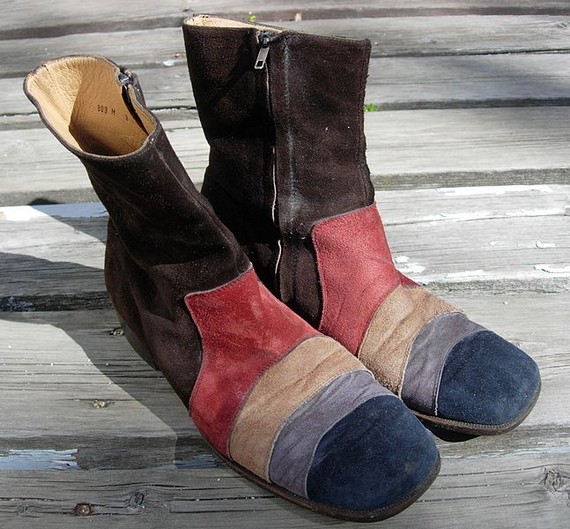
Rainbow suede boots ca. 1972
1970s Feet
Footwear styles were as diverse as clothing styles, but one dominant trend in 1970s fashion was the platform sole, available in a choice of heights, colours and styles of uppers to go with just about any outfit. The Mary Jane or simple court shoe was more popular for working women looking for something more discreet.
Boots were still in – a low heel complemented day-wear styles whilst a platform boots looked good with hot pants. The alternative to the platform was the slightly more comfortable stacked heel.
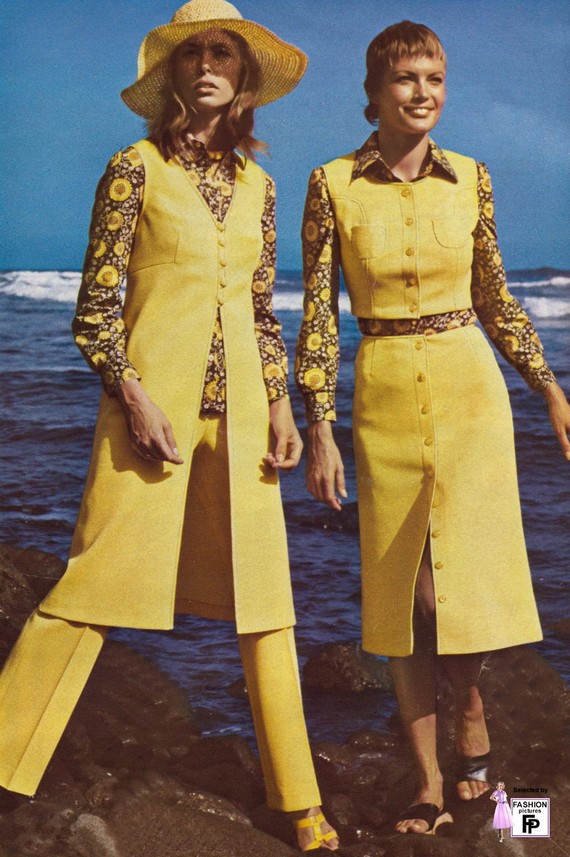
1970s fashion, A sunhat
.jpg )
Sensible shoe styles
Popular 1970s Jewellery
Chunky costume jewellery was favored, if worn at all. Silk scarves round the neck, whimsical hats and ostentatious belts often rendered jewellery unnecessary. Alternative the appropriate antique jewellery for the decade that was your preferred look was also collected.
.jpg )
A silk scarf, a bracelet and large sunglasses
The Favourite Hairstyles in 1970s fashion
1970s fashion saw a range of very different hairstyles for both men and women. Long and straight, parted in the middle or on the side was very prevalent, but after the hit TV series Charlie’s Angels debuted in 1976, women adopted a long style with “flicks” after its star, Farrah Fawcett.
Disco fever meant that hair became bigger and bigger, with Caucasian hair becoming waved, crimped and permed and black women letting their hair grow naturally without straightening into the popular Afro halo style. White men and women also adopted (or attempted to adopt) the Afro too.
Black women also cropped their hair extremely short to the head. In 1979 Bo Derek, a blonde white actress, wore braided cornrows for the film Ten, showing the influence of black beauty culture.
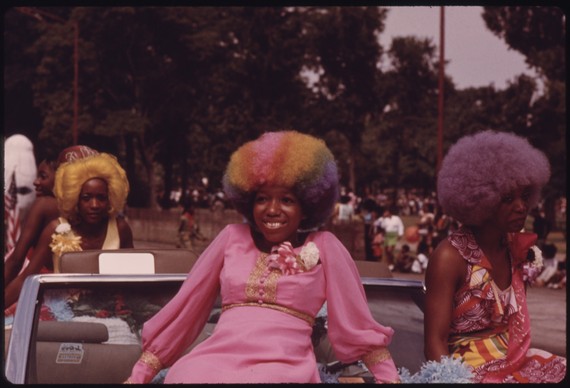
Three women in Afro wigs ride on car in the Bud Billiken Parade, Chicago, 1973

Ali MacGraw in 1972
1970s Makeup
Makeup wise, Biba styled their models in heavy makeup in unexpected colours of brown and bruised plum, appearing on the lips as well as eyes, and other eye colours included Air Force blue and leek green. The face of a Biba girl was painted white and eye, lip and cheek makeup was all prominent, with thin plucked eyebrows.
Eye makeup in 1970s fashion
Heavy eye makeup along with bright lipstick and a colourful triangle of blusher was also a hallmark of disco queens, but unlike the colours chosen by Biba aficionados disco colours were more optimistic, with red or fuchsia lipstick and gold, turquoise, blue or green eye makeup, or alternatively smoky silvers or greys.
In the most elaborate looks several shades of eye makeup were blended together to create sophisticated shading. Eyeliner and mascara were also used, and in some cases false eyelashes, but the intention wasn’t to create the wide-eyed and doll-like effect of the Sixties but a more grown up and womanly look.
1970s fashion – Dress for Success
For the woman adopting the “Dress for Success” working look, a more natural, “nude” makeup look was favoured, as women tried to downplay their femininity to compete with men in the workplace. It was advised to make this into a “day to night” look by adding red lipstick for after work drinks.
Hippies who were trying to avoid unnatural chemicals did not wear makeup at all, and punks, on the other hand, used make up in a different way, making a statement with artistic and often intimidating face paint.
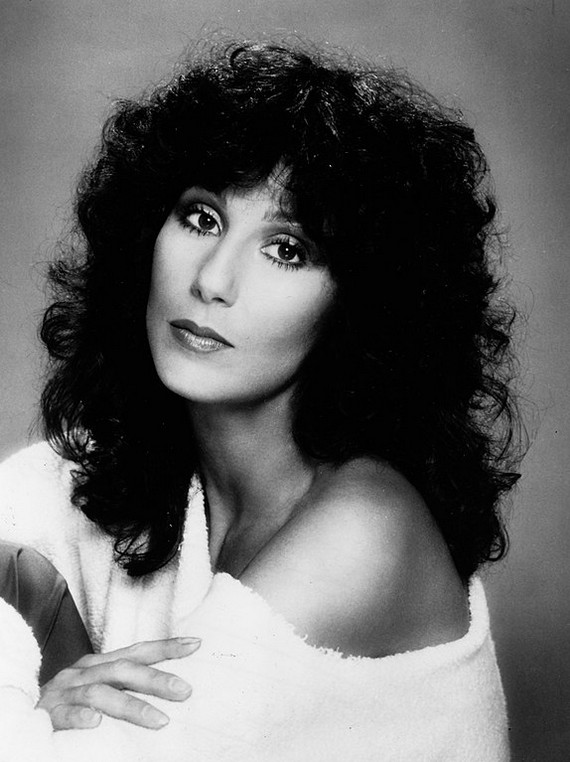
Cher in the 1970s – Casablanca
1970s Perfume
In line with the very different trends of trends for women, perfume bestsellers were quite different from each other. Opium by Yves Saint Laurent was launched in 1977. A rich oriental perfume for the sophisticated woman, it was meant as an evening scent and is still available.
Also still going is Charlie by Revlon, a scent that was marketed for the independent woman, and is light and fresh. Anais Anais by Cacharel came out in 1978 and was a huge hit, with its sweet notes, and so was Diorella, launched by Christian Dior in 1972. The fragrance, a blend of lemon, honeysuckle and vetiver, is still current. 1970s fashion lives on.
A Farrah Fawcett style mane of hair